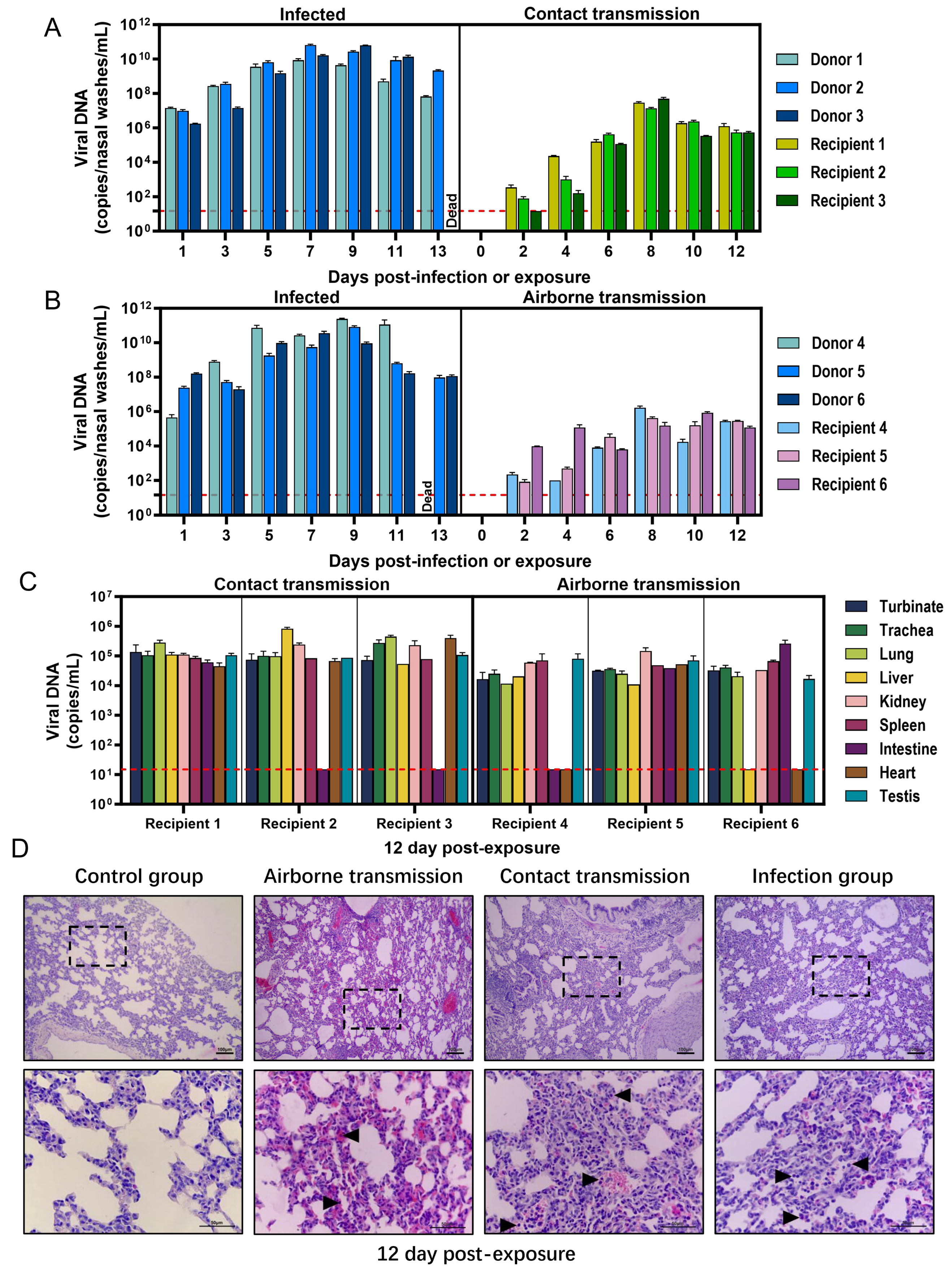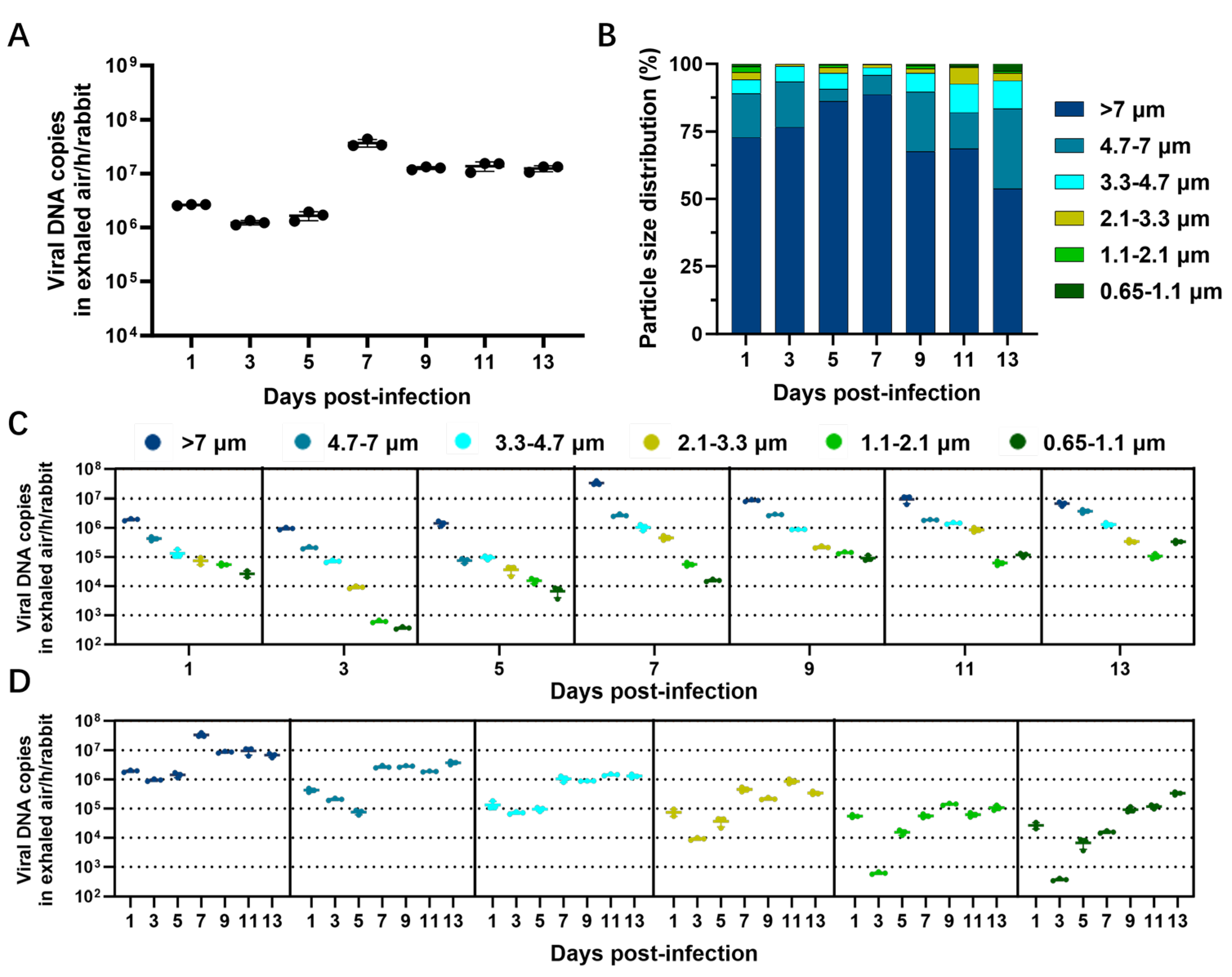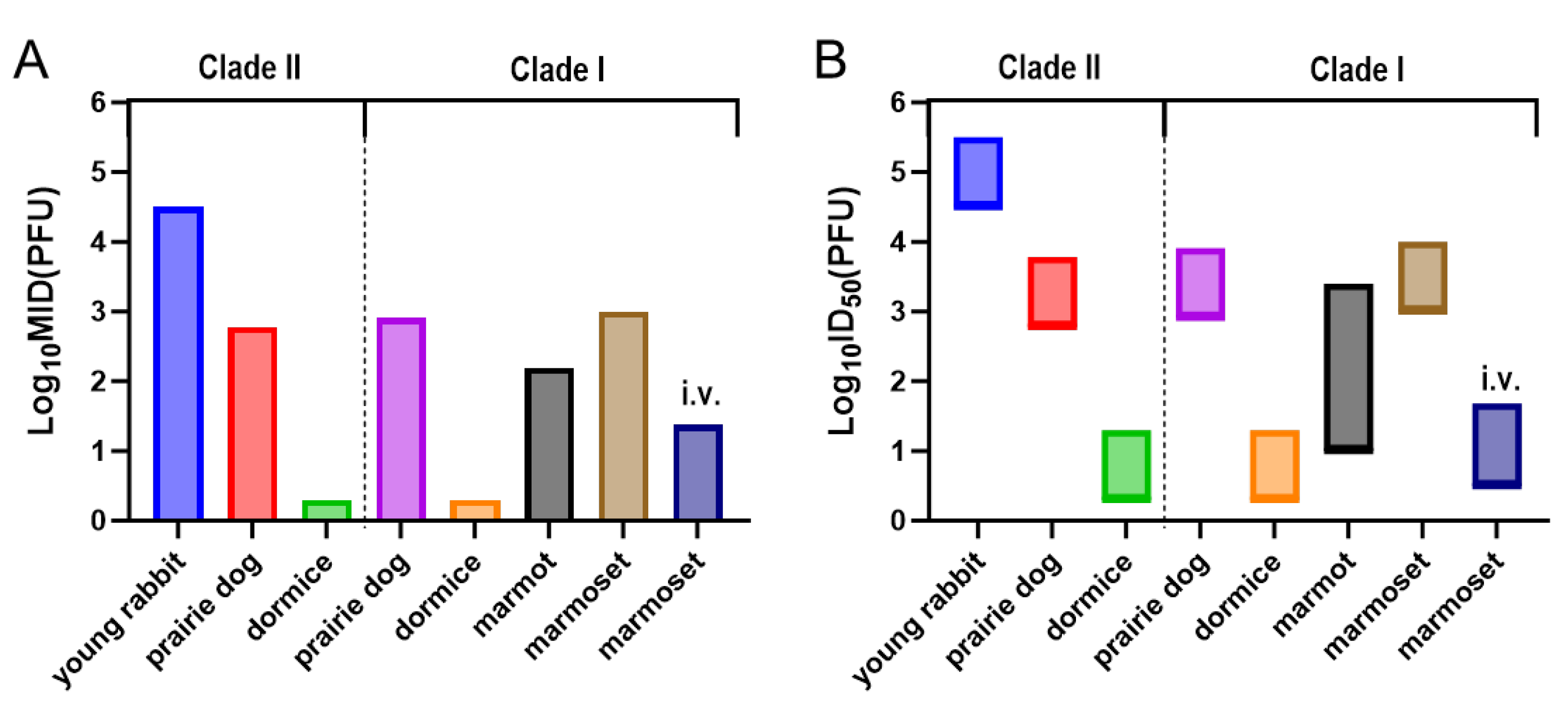Transmissibility of Clade IIb Monkeypox Virus in Young Rabbits
Abstract
1. Introduction
2. Materials and Methods
2.1. Ethics Statement
2.2. Virus and Cell
2.3. Animals and Viral Challenge
2.4. Pathogenicity of Monkeypox Virus in Young Rabbit
2.5. Transmissibility of Monkeypox Virus in Young Rabbit
2.6. Collection of Exhaled Viral Aerosols from Rabbit
2.7. Viral Nucleic Acid Detection
2.8. Statistical Analysis
3. Results
3.1. Body Weight Changes and Survival Rate of Rabbit Following MPXV Infection
3.2. Direct Contact and Airborne Transmissibility of MPXV in Rabbit
3.3. Concentrations and Particle Size Distribution of Viral Aerosols Exhaled by MPXV-Infected Rabbit
4. Discussion
Supplementary Materials
Author Contributions
Funding
Institutional Review Board Statement
Informed Consent Statement
Data Availability Statement
Acknowledgments
Conflicts of Interest
References
- Farasani, A. Monkeypox virus: Future role in Human population. J. Infect. Public Health 2022, 15, 1270–1275. [Google Scholar] [CrossRef]
- Alakunle, E.F.; Okeke, M.I. Monkeypox virus: A neglected zoonotic pathogen spreads globally. Nat. Rev. Microbiol. 2022, 20, 507–508. [Google Scholar] [CrossRef] [PubMed]
- Zemouri, C.; Beltrán, E.O.; Holliday, R.; Jakubovics, N.S.; Allison, J.R. Monkeypox: What do dental professionals need to know? Br. Dent. J. 2022, 233, 569–574. [Google Scholar] [CrossRef] [PubMed]
- Lu, J.; Xing, H.; Wang, C.; Tang, M.; Wu, C.; Ye, F.; Yin, L.; Yang, Y.; Tan, W.; Shen, L. Mpox (formerly monkeypox): Pathogenesis, prevention, and treatment. Signal Transduct. Target. Ther. 2023, 8, 458. [Google Scholar] [CrossRef]
- Multi-Country Outbreak of Mpox, External Situation Report #52-14 May 2025. Available online: https://www.who.int/publications/m/item/multi-country-outbreak-of-mpox--external-situation-report--52---14-may-2025 (accessed on 26 May 2025).
- Sah, R.; Abdelaal, A.; Reda, A.; Katamesh, B.E.; Manirambona, E.; Abdelmonem, H.; Mehta, R.; Rabaan, A.A.; Alhumaid, S.; Alfouzan, W.A.; et al. Monkeypox and Its Possible Sexual Transmission: Where Are We Now with Its Evidence? Pathogens 2022, 11, 924. [Google Scholar] [CrossRef] [PubMed]
- Kaler, J.; Hussain, A.; Flores, G.; Kheiri, S.; Desrosiers, D. Monkeypox: A comprehensive review of transmission, pathogenesis, and manifestation. Cureus 2022, 14, e26531. [Google Scholar] [CrossRef]
- Karagoz, A.; Tombuloglu, H.; Alsaeed, M.; Tombuloglu, G.; AlRubaish, A.A.; Mahmoud, A.; Smajlović, S.; Ćordić, S.; Rabaan, A.A.; Alsuhaimi, E. Monkeypox (mpox) virus: Classification, origin, transmission, genome organization, antiviral drugs, and molecular diagnosis. J. Infect. Public Health 2023, 16, 531–541. [Google Scholar] [CrossRef]
- Happi, C.; Adetifa, I.; Mbala, P.; Njouom, R.; Nakoune, E.; Happi, A.; Ndodo, N.; Ayansola, O.; Mboowa, G.; Bedford, T.; et al. Urgent need for a non-discriminatory and non-stigmatizing nomenclature for monkeypox virus. PLoS Biol. 2022, 20, e3001769. [Google Scholar] [CrossRef]
- Li, H.; Zhang, H.; Ding, K.; Wang, X.-H.; Sun, G.-Y.; Liu, Z.-X.; Luo, Y. The evolving epidemiology of monkeypox virus. Cytokine Growth Factor Rev. 2022, 68, 1–12. [Google Scholar] [CrossRef]
- Isidro, J.; Borges, V.; Pinto, M.; Sobral, D.; Santos, J.D.; Nunes, A.; Mixão, V.; Ferreira, R.; Santos, D.; Duarte, S.; et al. Phylogenomic characterization and signs of microevolution in the 2022 multi-country outbreak of monkeypox virus. Nat. Med. 2022, 28, 1569–1572. [Google Scholar] [CrossRef]
- Liu, B.M.; Rakhmanina, N.Y.; Yang, Z.; Bukrinsky, M.I. Mpox (Monkeypox) Virus and Its Co-Infection with HIV, Sexually Transmitted Infections, or Bacterial Superinfections: Double Whammy or a New Prime Culprit? Viruses 2024, 16, 784. [Google Scholar] [CrossRef]
- Shang, C.; Shi, S.; Jiang, Q.; Wang, X.; Yao, X.; Li, W.; Song, G.; Li, Y.; Sun, Y.; Hu, J.; et al. Clinical manifestations and pathogenicity of Clade IIb monkeypox virus in rabbits. Emerg. Microbes Infect. 2025, 14, 2465309. [Google Scholar] [CrossRef]
- Zhang, C.; Li, J.; Cui, H.; Jin, Y.; Chen, Z.; Zhang, L.; Song, S.; Lu, B.; Wang, Z.; Guo, Z. Lentinan Reduces Transmission Efficiency of COVID-19 by Changing Aerodynamic Characteristic of Exhaled SARS-CoV-2 Aerosols in Golden Hamsters. Microorganisms 2025, 13, 597. [Google Scholar] [CrossRef] [PubMed]
- Marennikova, S.S.; Seluhina, E.M. Susceptibility of some rodent species to monkeypox virus, and course of the infection. Bull. World Health Organ. 1976, 53, 13–20. [Google Scholar] [PubMed]
- Shchelukhina, E.M.; Marennikova, S.S. Generalized monkeypox in orally infected rabbits and white mice. Vopr. Virusol. 1975, 52, 703–705. [Google Scholar]
- Falendysz, E.A.; Lopera, J.G.; Doty, J.B.; Nakazawa, Y.; Crill, C.; Lorenzsonn, F.; Kalemba, L.N.; Ronderos, M.D.; Mejia, A.; Malekani, J.M.; et al. Characterization of monkeypox virus infection in African rope squirrels (Funisciurus sp.). PLoS Neglected Trop. Dis. 2017, 11, e0005809. [Google Scholar] [CrossRef]
- Hutson, C.L.; Carroll, D.S.; Gallardo-Romero, N.; Weiss, S.; Clemmons, C.; Hughes, C.M.; Salzer, J.S.; Olson, V.A.; Abel, J.; Karem, K.L.; et al. Monkeypox disease transmission in an experimental setting: Prairie dog animal model. PLoS ONE 2011, 6, e28295. [Google Scholar] [CrossRef]
- Hutson, C.L.; Gallardo-Romero, N.; Carroll, D.S.; Clemmons, C.; Salzer, J.S.; Nagy, T.; Hughes, C.M.; Olson, V.A.; Karem, K.L.; Damon, I.K. Transmissibility of the monkeypox virus clades via respiratory transmission: Investigation using the prairie dog-monkeypox virus challenge system. PLoS ONE 2013, 8, e55488. [Google Scholar] [CrossRef]
- Hutson, C.L.; Carroll, D.S.; Self, J.; Weiss, S.; Hughes, C.M.; Braden, Z.; Olson, V.A.; Smith, S.K.; Karem, K.L.; Regnery, R.L.; et al. Dosage comparison of Congo Basin and West African strains of monkeypox virus using a prairie dog animal model of systemic orthopoxvirus disease. Virology 2010, 402, 72–82. [Google Scholar] [CrossRef]
- Hutson, C.L.; Carroll, D.S.; Gallardo-Romero, N.; Drew, C.; Zaki, S.R.; Nagy, T.; Hughes, C.; Olson, V.A.; Sanders, J.; Patel, N.; et al. Comparison of Monkeypox Virus Clade Kinetics and Pathology within the Prairie Dog Animal Model Using a Serial Sacrifice Study Design. BioMed Res. Int. 2015, 20, 965710. [Google Scholar] [CrossRef]
- Leendertz, F.; Riutord-Fe, C.; Schlotterbeck, J.; Lagostina, L.; Kouadio, L.; Herridge, H.; Jochum, M.; Noma, N.; López-Morales, A.; Hoffmann, D.; et al. Fire-footed rope squirrels (Funisciurus pyrropus) are a reservoir host of monkeypox virus (Orthopoxvirus monkeypox). Res. Sq. 2025, preprint. [Google Scholar] [CrossRef]
- Tiee, M.S.; Harrigan, R.J.; Thomassen, H.A.; Smith, T.B. Ghosts of infections past: Using archival samples to understand a century of monkeypox virus prevalence among host communities across space and time. R. Soc. Open Sci. 2018, 5, 171089. [Google Scholar] [CrossRef] [PubMed]
- Schultz, D.A.; Sagartz, J.E.; Huso, D.L.; Buller, R.M.L. Experimental infection of an african dormouse (graphiurus kelleni) with monkeypox virus. Virology 2009, 383, 86–92. [Google Scholar] [CrossRef] [PubMed]
- Sergeev, A.A.; Kabanov, A.S.; Bulychev, L.E.; Sergeev, A.A.; Pyankov, O.V.; Bodnev, S.A.; Galahova, D.O.; Zamedyanskaya, A.S.; Titova, K.A.; Glotova, T.I.; et al. Using the Ground Squirrel (Marmota bobak) as an Animal Model to Assess Monkeypox Drug Efficacy. Transbound. Emerg. Dis. 2017, 64, 226–236. [Google Scholar] [CrossRef]
- Sergeev, A.A.; Kabanov, A.S.; Bulychev, L.E.; Sergeev, A.A.; Pyankov, O.V.; Bodnev, S.A.; Galakhova, D.O.; Zamedyanskaya, A.S.; Titova, K.A.; Shishkina, L.N.; et al. Development of the disease in marmot at the intranasal infection with the monkeypox virus. Vopr. Virusol. 2015, 60, 37–41. [Google Scholar]
- Heberling, R.L.; Kalter, S.S. Induction, Course, and Transmissibility of Monkeypox in the Baboon (Papio cynocephalus). J. Infect. Dis. 1971, 124, 33–38. [Google Scholar] [CrossRef]
- Mucker, E.M.; Chapman, J.; Huzella, L.M.; Huggins, J.W.; Shamblin, J.; Robinson, C.G.; Hensley, L.E. Susceptibility of marmosets (callithrix jacchus) to monkeypox virus: A low dose prospective model for monkeypox and smallpox disease. PLoS ONE 2015, 10, e0131742. [Google Scholar] [CrossRef]
- Mucker, E.M.; Wollen-Roberts, S.E.; Kimmel, A.; Shamblin, J.; Sampey, D.; Hooper, J.W. Intranasal monkeypox marmoset model: Prophylactic antibody treatment provides benefit against severe monkeypox virus disease. PLoS Neglected Trop. Dis. 2018, 12, e0006581. [Google Scholar] [CrossRef]
- Wells, W.F. On air-borne infection*: Study II. Droplets and droplet nuclei. Am. J. Epidemiol. 1934, 20, 611–618. [Google Scholar] [CrossRef]
- Leung, N.H.L. Transmissibility and transmission of respiratory viruses. Nat. Rev. Microbiol. 2021, 19, 528–545. [Google Scholar] [CrossRef]
- Boydston, J.A.; Biryukov, J.; Yeager, J.J.; Zimmerman, H.A.; Williams, G.; Green, B.; Reese, A.L.; Beck, K.; Bohannon, J.K.; Miller, D.; et al. Aerosol Particle Size Influences the Infectious Dose and Disease Severity in a Golden Syrian Hamster Model of Inhalational COVID-19. J. Aerosol Med. Pulm. Drug Deliv. 2023, 36, 235–245. [Google Scholar] [CrossRef]




| Species | MID(log10 PFU) | ID50(log10 PFU) | Inoculation Route | Clade | Strain | Determination of Infection | Transmissibility |
|---|---|---|---|---|---|---|---|
| young rabbit [13] | 4.50 | 4.5~5.5 | i.n. | II | hMpxV/China/GZ8H-01/2023 | Weight changes and DNA detection results | Ineffective |
| Prairie dogs [19,20,21] | 2.78 | 2.78~3.78 | i.n. | II | MPXV-USA-2003-044 | Clinical manifestations and antibody seroconversion | 100% contact transmission efficiency [18,19] |
| 2.91 | 2.91~3.91 | i.n. | I | MPXV-ROC-2003-358 | Clinical manifestations and antibody seroconversion | 17% airborne transmission efficiency [19] | |
| dormice [24] | 0.30 | 0.3~1.3 | i.n. | II | MPXV-COP-58 | Mortality rate and weight | unknown |
| 0.30 | 0.3~1.3 | i.n. | I | MPXV-ZAI-79 | Mortality rate and weight | unknown | |
| Marmot [25,26] | 2.20 | 2.2 ± 1.2 | i.n. | I | V79-1-005 | Clinical manifestations | unknown |
| Marmoset [28,29] | 3.00 | 3.0~4.0 | i.n. | I | V79-1-005 | Clinical manifestations | unknown |
| <1.68 | <1.68 | i.v. | I | V79-1-005 | Clinical manifestations | unknown | |
| Rope squirrels | - | - | i.n. | I | MPXV-2003-Congo-358 | - | Airborne and cross-species transmission cases exist. [17,22] |
| Baboon | - | - | i.m. | - | 7-61 WRAIR | - | natural transmission cases exist [27] |
Disclaimer/Publisher’s Note: The statements, opinions and data contained in all publications are solely those of the individual author(s) and contributor(s) and not of MDPI and/or the editor(s). MDPI and/or the editor(s) disclaim responsibility for any injury to people or property resulting from any ideas, methods, instructions or products referred to in the content. |
© 2025 by the authors. Licensee MDPI, Basel, Switzerland. This article is an open access article distributed under the terms and conditions of the Creative Commons Attribution (CC BY) license (https://creativecommons.org/licenses/by/4.0/).
Share and Cite
Chen, Z.; Zhang, L.; Li, L.; Shao, M.; Zhang, M.; Zhao, Z.; Shang, C.; Liu, Z.; Liu, J.; Guo, Z. Transmissibility of Clade IIb Monkeypox Virus in Young Rabbits. Microorganisms 2025, 13, 2182. https://doi.org/10.3390/microorganisms13092182
Chen Z, Zhang L, Li L, Shao M, Zhang M, Zhao Z, Shang C, Liu Z, Liu J, Guo Z. Transmissibility of Clade IIb Monkeypox Virus in Young Rabbits. Microorganisms. 2025; 13(9):2182. https://doi.org/10.3390/microorganisms13092182
Chicago/Turabian StyleChen, Zhaoliang, Lei Zhang, Linzhi Li, Mingjie Shao, Mingda Zhang, Zongzheng Zhao, Chao Shang, Zirui Liu, Juxiang Liu, and Zhendong Guo. 2025. "Transmissibility of Clade IIb Monkeypox Virus in Young Rabbits" Microorganisms 13, no. 9: 2182. https://doi.org/10.3390/microorganisms13092182
APA StyleChen, Z., Zhang, L., Li, L., Shao, M., Zhang, M., Zhao, Z., Shang, C., Liu, Z., Liu, J., & Guo, Z. (2025). Transmissibility of Clade IIb Monkeypox Virus in Young Rabbits. Microorganisms, 13(9), 2182. https://doi.org/10.3390/microorganisms13092182







